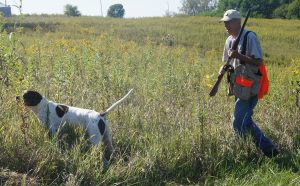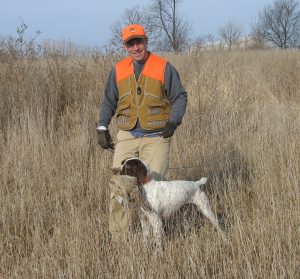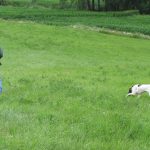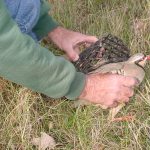Pages from the Past
POINTING DOG POINTERS
By Bob and Jody Iler
All good pointing dog trainers keep an open mind and learn everything they can from many other sources. And that includes you – as you consult trainers, read books and articles, and watch training videos – trying to piece all the information together. Maybe you’re working with your first pointing dog in your first season, and you’re wondering how you are measuring up as a trainer.
As we turn the calendar to a new year, we got out some of the old pointing dog training books in our library, several written nearly 100 years ago. We wanted to see what we could find from a few of the old “bird dog masters” to reinforce the idea that establishing a bond with your dog and learning from him are keys to his successful development.
That All-Important Bond
 Horace Lytle, in his book How to Train Your Bird Dog, shares this bit of wisdom: “The most important rule of all is to love and know your dog – and make sure that he loves and knows you . . . There must be the closest possible similar bond between you and the dog you are attempting to teach to hunt for you in the field.”
Horace Lytle, in his book How to Train Your Bird Dog, shares this bit of wisdom: “The most important rule of all is to love and know your dog – and make sure that he loves and knows you . . . There must be the closest possible similar bond between you and the dog you are attempting to teach to hunt for you in the field.”
In Snakefoot – The Making of a Champion, Robert G. Wehle says, “It’s necessary to know the dog extremely well in order to develop all his qualities to their fullest – much the same as raising a child. In this process, you have to convince him that he’s really a great dog and that you’re eight feet tall. Soon a mutual respect will surface and this is when development and training become so easy and effective and the whole process becomes enjoyable for you and the dog.”
Earl C. Crangle, in his book Pointing Dogs: Their Training and Handling, offers the following: “When a bond exists between dog and human, the desire of the dog is to do right rather than wrong and you can show your displeasure by scolding an incorrect performance, thereby hurting the dog more than anything you could physically.”
Spending time with our dog from the day we bring him home as a pup is crucial to developing the bond described in the pages of these old books. Pup learns that we are the center of his world; that we provide food, comfort, security, fun, and learning – but most important – love and understanding as he develops into a top notch pointing dog. Acquiring a started dog makes this process a little more complicated, as we’ll want to work with the trainer before we even bring our started dog home. We’ll want to learn the commands he’s been taught, how he’s been handled and disciplined, and work with our dog and the trainer in the field. Then we’ll want to spend time becoming our dog’s #1 person when we bring him home. We’ll take all the time that’s needed to first establish that all-important bond so necessary to our mutual relationship.
Know Your Dog and Learn
Er M. Shelley, in his book Bird Dog Training: Today and Tomorrow, says: “To begin with, it must be understood that scarcely two dogs of exactly the same temperament and disposition are to be found . . . This being the case it is quite apparent that nearly every dog requires slightly different handling, in some respect, than all others. Hence there are no set rules to be followed. A rule that works perfectly with one dog would not answer at all for another.”
Robert Wehle (from Snakefoot) adds: “Keep trying to determine what the dog is thinking and what his reactions should be to your teachings. It is in this area where dog and man, student and teacher so often fall apart: the trainer overestimating the dog’s capacity to learn or the trainer poorly presenting the lesson.”
Earl Crangle shares: “Many times, the fault of the performance does not lie with the dog, but in his handling . . . Maintenance of training is the owner’s responsibility, testing the dog’s memory with frequent sessions to brush up reinforces training, and helps the dog give top performances all his life.”
Paul Long, in his book Training Pointing Dogs believes that if you train your own dog, “you’ll get to know your dog better and more about your own limitations in ability and temperament . . . I believe that anyone can train a bird dog if he will pay close attention to this book.” He also says: “Dogs have excellent memories. Their recall is terrific, but they do not think. Memory and instinct, not thought, guide their actions. But you can think. Do that if your dog slips back in his training. Somehow, somewhere, some act of yours, or failure to act, is responsible.”
In his first book, Wing and Shot, Wehle says, “Training a dog is actually quite a simple feat to perform if it is approached in an organized manner and the simple steps set forth here are followed . . . Anyone with a desire to learn and a love of dogs can accomplish it without difficulty . . . The truth is that the problem at hand is more one of training the trainer than training the dog . . . you will find scattered through it [the book] many suggestions regarding the performance of the trainer, his mental attitude, patience, affection, consistency, self-control, understanding and tolerance.”
In these old books we are reassured that there is “more than one way to skin a cat” – that though there are basic training precepts that are adjusted to fit each particular dog’s training program, there is really no right way – only what is right for you and your dog. The general sentiment also seems to be that there is no magic involved in becoming a good dog trainer. Rather, if you learn to “read” your dog, and spend time figuring out what he is trying to tell you in canine terms, you will know what to do. You’ll realize that you may have put too much pressure on him too soon, before he is ready for a particular lesson. You’ll learn that there is no timetable, but that you must be firm, consistent, fair and kind. That you must make training fun and leave the dog with his appetite whetted at the end of each session. That you won’t overwork him, lend him out to others, hunt him with dogs of lesser training or too many hunters with too many guns. The great secret to dog training is this: you will make mistakes along the way, but if you love and respect your hunting partner and learn all that you can as you train him, it will be all right.
Over the years there have been new innovations to be used in training our dogs and improvements to enhance our roles as good, humane trainers. But in the end, many of the old tried and true methods of training still pass the test of time, as important today as they were a century or more ago.
Pointing Dog Pointers features monthly training tips by Bob and Jody Iler, who own Green Valley Kennels in Dubuque, Iowa. Bob and Jody have trained pointing dogs for over 35 years and have written many articles for The Pointing Dog Journal.






